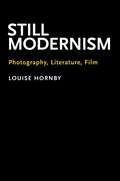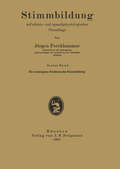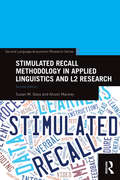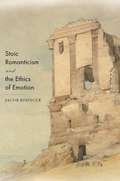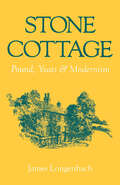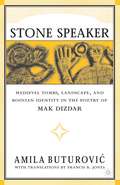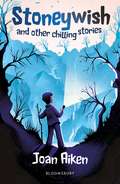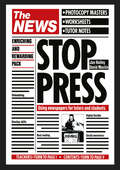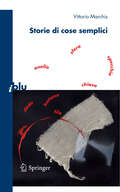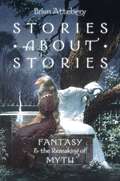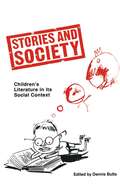- Table View
- List View
Still Modernism: Photography, Literature, Film
by Louise HornbyStill Modernism offers a critique of the modernist imperative to embrace motion, speed, and mobility. In the context of the rise of kinetic technologies and the invention of motion pictures, it claims that stillness is nonetheless an essential tactic of modernist innovation. More specifically, the book looks at the ways in which photographic stillness emerges as a counterpoint to motion and to film, asserting its own clear visibility against the blur of kinesis. Photographic stillness becomes a means to resist the ephemerality of motion and to get at and articulate something real or essential by way of its fixed limits. Combining art history, film studies and literary studies, Louise Hornby reveals how photographers, filmmakers, and writers, even at their most kinetic, did not surrender attention to points of stillness. Rather, the still image, understood through photography, establishes itself as a mode of resistance and provides a formal response to various modernist efforts to see better, to attend more closely, and to remove the fetters of subjectivity and experience. Still Modernism brings together a series of canonical texts, films, and photographs, the selection of which reinforces the central claim that stillness does not lurk at the margins of modernism, but was constitutive of its very foundations. In a series of comparisons drawing from literary and visual objects, Hornby argues that still photography allows film to access its own diffuse images of motion; photography's duplicative form provides a serial structure for modernist efforts to represent the face; its iterative structure articulates the jerky rhythms of experimental narrative as perambulation; and its processes of development allow for the world to emerge independent of the human observer. Casting new light on the relationship between photography and film, Hornby situates the struggle between the still and the kinetic at the center of modernist culture.
Still Modernism: Photography, Literature, Film
by Louise HornbyStill Modernism offers a critique of the modernist imperative to embrace motion, speed, and mobility. In the context of the rise of kinetic technologies and the invention of motion pictures, it claims that stillness is nonetheless an essential tactic of modernist innovation. More specifically, the book looks at the ways in which photographic stillness emerges as a counterpoint to motion and to film, asserting its own clear visibility against the blur of kinesis. Photographic stillness becomes a means to resist the ephemerality of motion and to get at and articulate something real or essential by way of its fixed limits. Combining art history, film studies and literary studies, Louise Hornby reveals how photographers, filmmakers, and writers, even at their most kinetic, did not surrender attention to points of stillness. Rather, the still image, understood through photography, establishes itself as a mode of resistance and provides a formal response to various modernist efforts to see better, to attend more closely, and to remove the fetters of subjectivity and experience. Still Modernism brings together a series of canonical texts, films, and photographs, the selection of which reinforces the central claim that stillness does not lurk at the margins of modernism, but was constitutive of its very foundations. In a series of comparisons drawing from literary and visual objects, Hornby argues that still photography allows film to access its own diffuse images of motion; photography's duplicative form provides a serial structure for modernist efforts to represent the face; its iterative structure articulates the jerky rhythms of experimental narrative as perambulation; and its processes of development allow for the world to emerge independent of the human observer. Casting new light on the relationship between photography and film, Hornby situates the struggle between the still and the kinetic at the center of modernist culture.
Still Thriving: On the Importance of Aranye Fradenburg
by L.O. Aranye Fradenburghe work of L.O. Aranye Fradenburg, especially her psychoanalytic criticism of Chaucer, and her formulations of discontinuist historical approaches to the Middle Ages, has been extremely influential within medieval studies for the past 20 or so years. More recently she has been focusing on more broad defenses of the humanities, especially with regard to the valuable role of literary studies relative to the arts of everyday living, eudaimonia [flourishing], ethical community, and well-being, and also on psychoanalysis itself as a “liberal art.” Relationality, intersubjectivity, aliveness, resilience, care of the self and also of others, adaptive flexibility, playfulness, shared attention, companionship, healing, and thriving seem, increasingly, to be the key watchwords and concerns of Fradenburg’s work, and at the same time, the so-called “literary” mode is still central to these concerns, such that, as Fradenburg has written, “Interpretation and relationality depend on one another because all relationships are unending processes of interpretation and expression, listening and signifying. In turn, sentience assists relationality: we can’t thrive and probably can’t survive without minds open to possibility, capable of sensing and interpreting the tiniest shifts in, e.g., pitch and tone.” This small volume features short essays and personal reflections on the importance of Fradenburg’s career, as teacher and scholar, and also on the valuable role(s) that her work, and medieval studies more generally, has played and might still play in the defense of the humanities as essential to living and thriving.
The Stillbirth of Capital: Enlightenment Writing and Colonial India
by Siraj AhmedThis book targets one of the humanities' most widely held premises: namely, that the European Enlightenment laid the groundwork for modern imperialism. It argues instead that the Enlightenment's vision of empire calls our own historical and theoretical paradigms into question. While eighteenth-century British India has not received nearly the same attention as nineteenth- and twentieth-century empires, it is the place where colonial rule and Enlightenment reason first became entwined. The Stillbirth of Capital makes its case by examining every work about British India written by a major author from 1670 to 1815, a period that coincides not only with the Enlightenment but also with the institution of a global economy. In contrast to both Marxist and liberal scholars, figures such as Dryden, Defoe, Voltaire, Sterne, Smith, Bentham, Burke, Sheridan, and Scott locate modernity's roots not in the birth of capital but rather in the collusion of sovereign power and monopoly commerce, which used Indian Ocean wealth to finance the unfathomable costs of modern war. Ahmed reveals the pertinence of eighteenth-century writing to our own moment of danger, when the military alliance of hegemonic states and private corporations has become even more far-reaching than it was in centuries past.
Stimmbildung auf stimm- und sprachphysiologischer Grundlage: Erster Band Die wichtigsten Probleme der Stimmbildung (Stimmbildung auf stimm- und sprachphysiologischer Grundlage #1)
by Jörgen ForchhammerDieser Buchtitel ist Teil des Digitalisierungsprojekts Springer Book Archives mit Publikationen, die seit den Anfängen des Verlags von 1842 erschienen sind. Der Verlag stellt mit diesem Archiv Quellen für die historische wie auch die disziplingeschichtliche Forschung zur Verfügung, die jeweils im historischen Kontext betrachtet werden müssen. Dieser Titel erschien in der Zeit vor 1945 und wird daher in seiner zeittypischen politisch-ideologischen Ausrichtung vom Verlag nicht beworben.
Stimulated Recall Methodology in Applied Linguistics and L2 Research (Second Language Acquisition Research Series)
by Susan M. Gass Alison MackeyStimulated Recall Methodology in Applied Linguistics and L2 Research provides researchers and students in second language acquisition and applied linguistics with the only how-to guide on using stimulated recalls in their research practice. This new edition expands on the scope of the previous edition, walking readers step-by-step through a range of studies in applied linguistics in order to demonstrate the history of stimulated recalls and their efficacy as a data collection tool. With its exclusive focus on stimulated recalls, coverage of the most up-to-date research studies, and pedagogically rich text design, Stimulated Recall Methodology in Applied Linguistics and L2 Research supplies researchers and students with the practical skills to elicit richer data in their own research.
Stimulated Recall Methodology in Applied Linguistics and L2 Research (Second Language Acquisition Research Series)
by Susan M. Gass Alison MackeyStimulated Recall Methodology in Applied Linguistics and L2 Research provides researchers and students in second language acquisition and applied linguistics with the only how-to guide on using stimulated recalls in their research practice. This new edition expands on the scope of the previous edition, walking readers step-by-step through a range of studies in applied linguistics in order to demonstrate the history of stimulated recalls and their efficacy as a data collection tool. With its exclusive focus on stimulated recalls, coverage of the most up-to-date research studies, and pedagogically rich text design, Stimulated Recall Methodology in Applied Linguistics and L2 Research supplies researchers and students with the practical skills to elicit richer data in their own research.
Stimulating Student Interest in Language Learning: Theory, Research and Practice
by Tan Bee TinThis book explores the issues and concerns many language teachers have in not just helping able students to learn a foreign or second language but more importantly how to get reluctant learners to become interested in language learning. Tin proposes ‘interest’ as an important construct that requires investigation if we are to understand second language learning experiences in a modern globalised world. The book offers both theoretical explorations and empirical findings arising from the author’s own research in the field. Chapters demonstrate how various theoretical and empirical findings can be applied to practice so as to raise the awareness of the importance of interest in language learning and teaching. For teacher trainers and educators, researchers, and practising language teachers, this comprehensive study provides tools to stimulate student interest in language learning for successful language learning.
Stock Characters Speaking: Eight Libanian Declamations Introduced and Translated
by Robert PenellaDeclamations were composed and orally delivered in the Roman Empire by sophists, or teachers of rhetoric, of whom the Greek-speaking Libanius was one of the most distinguished. Stock Characters Speaking may be thought of as emerging from three developments of recent decades: an explosive interest in late antiquity, a newly sympathetic interest in rhetoric (including ancient declamation), and a desire to bring Libanius’s massive corpus into English and other modern languages. In this book, author Robert J. Penella translates eight of Libanius’s declamations: 29, 30, 34, 35, 37, 45, 46, 47, and, in an appendix, the thirteenth-century Gregory of Cyprus’s response to Declamation 34. Each translation is accompanied by an introduction, in which Penella examines the themes, structure, and the stasis, or key issue, of the declamations. Figures who appear in the translated declamations include a parasite who has lost his patron, a man envious of his rich neighbor, a miser’s son, a poor man willing to die for his city, a rich war-hero accused of aiming at tyranny, and a convict asking for exile. Three of these declamations have appeared in German; otherwise, these translations are the first into a modern language.
Stoic Romanticism and the Ethics of Emotion
by Jacob RisingerAn exploration of Stoicism’s central role in British and American writing of the Romantic periodStoic philosophers and Romantic writers might seem to have nothing in common: the ancient Stoics championed the elimination of emotion, and Romantic writers made a bold new case for expression, adopting “powerful feeling” as the bedrock of poetry. Stoic Romanticism and the Ethics of Emotion refutes this notion by demonstrating that Romantic-era writers devoted a surprising amount of attention to Stoicism and its dispassionate mandate. Jacob Risinger explores the subterranean but vital life of Stoic philosophy in British and American Romanticism, from William Wordsworth to Ralph Waldo Emerson. He shows that the Romantic era—the period most polemically invested in emotion as art’s mainspring—was also captivated by the Stoic idea that aesthetic and ethical judgment demanded the transcendence of emotion.Risinger argues that Stoicism was a central preoccupation in a world destabilized by the French Revolution. Creating a space for the skeptical evaluation of feeling and affect, Stoicism became the subject of poetic reflection, ethical inquiry, and political debate. Risinger examines Wordsworth’s affinity with William Godwin’s evolving philosophy, Samuel Taylor Coleridge’s attempt to embed Stoic reflection within the lyric itself, Lord Byron’s depiction of Stoicism at the level of character, visions of a Stoic future in novels by Mary Shelley and Sarah Scott, and the Stoic foundations of Emerson’s arguments for self-reliance and social reform.Stoic Romanticism and the Ethics of Emotion illustrates how the austerity of ancient philosophy was not inimical to Romantic creativity, but vital to its realization.
Stoic Romanticism and the Ethics of Emotion
by Jacob RisingerAn exploration of Stoicism’s central role in British and American writing of the Romantic periodStoic philosophers and Romantic writers might seem to have nothing in common: the ancient Stoics championed the elimination of emotion, and Romantic writers made a bold new case for expression, adopting “powerful feeling” as the bedrock of poetry. Stoic Romanticism and the Ethics of Emotion refutes this notion by demonstrating that Romantic-era writers devoted a surprising amount of attention to Stoicism and its dispassionate mandate. Jacob Risinger explores the subterranean but vital life of Stoic philosophy in British and American Romanticism, from William Wordsworth to Ralph Waldo Emerson. He shows that the Romantic era—the period most polemically invested in emotion as art’s mainspring—was also captivated by the Stoic idea that aesthetic and ethical judgment demanded the transcendence of emotion.Risinger argues that Stoicism was a central preoccupation in a world destabilized by the French Revolution. Creating a space for the skeptical evaluation of feeling and affect, Stoicism became the subject of poetic reflection, ethical inquiry, and political debate. Risinger examines Wordsworth’s affinity with William Godwin’s evolving philosophy, Samuel Taylor Coleridge’s attempt to embed Stoic reflection within the lyric itself, Lord Byron’s depiction of Stoicism at the level of character, visions of a Stoic future in novels by Mary Shelley and Sarah Scott, and the Stoic foundations of Emerson’s arguments for self-reliance and social reform.Stoic Romanticism and the Ethics of Emotion illustrates how the austerity of ancient philosophy was not inimical to Romantic creativity, but vital to its realization.
Stolen Language?: Plagiarism in Writing (Real Language Series)
by Shelley Angelil-CarterReal Language SeriesGeneral Editors-Jennifer Coates, Jenny Cheshire and Euan ReidThis is a sociolinguistic series about the relationships between language, society and social change. Books in the series draw on natural language data from a wide range of social contexts. The series takes a critical approach to the subject, challenging current orthodoxies, and dealing with familiar topics in new ways. The topic of plagiarism is a highly contentious issue and one that is of growing interest and importance in higher education across the world. Stolen Language? Plagiarism in Writing uncovers the reasons why students plagiarize, and explains what can be done about it. It challenges the concepts of original authorship of language, tracing the notion of plagiarism to the introduction of copyright laws in the eighteenth century. The analysis presented in this book explores plagiarism as complex and contested, and suggests that in student academic writing it may be the surface manifestation of learning difficulties related to the educational environment, the nature of academic discourse and the nature of language.Underlying the concept of plagiarism is the premise that meaning is made by the individual, using the system of language at his or her disposal. The words and ideas then belong to the individual who first thought of them, or who first used these words in a particular way. New understandings, that language and cognition are fundamentally social and cultural, contest the idea of 'original thought' or 'original language'. In addition, what constitutes plagiarism differs depending on the genre and context of writing.Stolen Language shows that there is in any good writing an authorial presence, an authorial voice which is particularly difficult for the novice writer to control when constructing an essay based on multiple texts. Written in a unique and accessible way, the book also looks at the particular difficulties experienced by writers of English as an additional language and provides a practical framework for academics and teachers of writing on how to develop authorial voice and critical thinking in the student writer.
Stolen Language?: Plagiarism in Writing (Real Language Series)
by Shelley Angelil-CarterReal Language SeriesGeneral Editors-Jennifer Coates, Jenny Cheshire and Euan ReidThis is a sociolinguistic series about the relationships between language, society and social change. Books in the series draw on natural language data from a wide range of social contexts. The series takes a critical approach to the subject, challenging current orthodoxies, and dealing with familiar topics in new ways. The topic of plagiarism is a highly contentious issue and one that is of growing interest and importance in higher education across the world. Stolen Language? Plagiarism in Writing uncovers the reasons why students plagiarize, and explains what can be done about it. It challenges the concepts of original authorship of language, tracing the notion of plagiarism to the introduction of copyright laws in the eighteenth century. The analysis presented in this book explores plagiarism as complex and contested, and suggests that in student academic writing it may be the surface manifestation of learning difficulties related to the educational environment, the nature of academic discourse and the nature of language.Underlying the concept of plagiarism is the premise that meaning is made by the individual, using the system of language at his or her disposal. The words and ideas then belong to the individual who first thought of them, or who first used these words in a particular way. New understandings, that language and cognition are fundamentally social and cultural, contest the idea of 'original thought' or 'original language'. In addition, what constitutes plagiarism differs depending on the genre and context of writing.Stolen Language shows that there is in any good writing an authorial presence, an authorial voice which is particularly difficult for the novice writer to control when constructing an essay based on multiple texts. Written in a unique and accessible way, the book also looks at the particular difficulties experienced by writers of English as an additional language and provides a practical framework for academics and teachers of writing on how to develop authorial voice and critical thinking in the student writer.
Stone Cottage: Pound, Yeats, and Modernism
by James LongenbachAlthough readers of modern literature have always known about the collaboration of W.B. Yeats and Ezra Pound, the crucial winters these poets spent living together in Stone Cottage in Sussex (1913-1916) have remained a mystery. Working from a large base of previously unpublished material, James Longenbach presents for the first time the untold story of these three winters. Inside the secret world of Stone Cottage, Pound's Imagist poems were inextricably linked to Yeats's studies in spiritualism and magic, and early drafts of The Cantos reveal that the poem began in response to the same esoteric texts that shaped Yeats's visionary system. At the same time, Yeats's autobiographies and Noh-style plays took shape with Pound's assistance. Having retreated to Sussex to escape the flurry of wartime London, both poets tracked the progress of the Great War and in response wrote poems--some unpublished until now--that directly address the poet's political function. More than the story of a literary friendship, Stone Cottage explores the Pound-Yeats connection within the larger context of modern literature and culture, illuminating work that ranks with the greatest achievements of modernism.
Stone Speaker: Medieval Tombs, Landscape, and Bosnian Identity in the Poetry of Mak Dizdar
by A. ButurovicThe Poet Mak Dizdar (d.1971) has become a cultural icon in contemporary Bosnia-Herzegovina. Inspired by the lapidary imagery and epitaphs of medieval Bosnian tombstones, his best-acclaimed collection of poetry, Stone Sleeper , reawakens the medieval voices and assigns them a new role in the historical imagination of contemporary Bosnians. In this study, Amila Buturovic looks at Stone Sleeper's recovery of the ancestral world as an effort to refashion the sentiments of collective belonging. In treating the medieval tombstones as sites of collective memory, Dizdar's poetry evokes new possibilities for Bosnians to cast aside national differences based primarily on religion and embrace a pluralistic identity rooted in the sacred landscape of medieval Bosnia.
Stoneywish and other chilling stories: A Bloomsbury Reader (Bloomsbury Readers)
by Joan AikenA brilliant collection of spine-chilling tales by Joan Aiken, author of The Wolves of Willoughby Chase. From a mysterious traveller who leaves an injured horse with a stranger, to a garden plant that slowly creeps into a house during a thunderstorm and a man who comes across two angry forces in the middle of a forest, this chilling collection of stories will have readers jumping at bumps in the night.Much-loved author Joan Aiken is best known for The Wolves of Willoughby Chase and the Arabel and Mortimer books. This brilliant collection has spooky black-and-white illustrations by TBC and is perfect for children who are developing as readers. The Bloomsbury Readers series is packed with brilliant books to get children reading independently in Key Stage 2, with book-banded stories by award-winning authors like double Carnegie Medal winner Geraldine McCaughrean and Waterstones Prize winner Patrice Lawrence, covering a wide range of genres and topics. With charming illustrations and online guided reading notes written by the Centre for Literacy in Primary Education (CLPE), this series is ideal for reading both in the classroom and at home. For more information visit www.bloomsburyguidedreading.com.Book Band: Dark BlueIdeal for ages 8+
Stoneywish and other chilling stories: A Bloomsbury Reader (Bloomsbury Readers)
by Joan AikenA brilliant collection of spine-chilling tales by Joan Aiken, author of The Wolves of Willoughby Chase. From a mysterious traveller who leaves an injured horse with a stranger, to a garden plant that slowly creeps into a house during a thunderstorm and a man who comes across two angry forces in the middle of a forest, this chilling collection of stories will have readers jumping at bumps in the night.Much-loved author Joan Aiken is best known for The Wolves of Willoughby Chase and the Arabel and Mortimer books. This brilliant collection has spooky black-and-white illustrations by TBC and is perfect for children who are developing as readers. The Bloomsbury Readers series is packed with brilliant books to get children reading independently in Key Stage 2, with book-banded stories by award-winning authors like double Carnegie Medal winner Geraldine McCaughrean and Waterstones Prize winner Patrice Lawrence, covering a wide range of genres and topics. With charming illustrations and online guided reading notes written by the Centre for Literacy in Primary Education (CLPE), this series is ideal for reading both in the classroom and at home. For more information visit www.bloomsburyguidedreading.com.Book Band: Dark BlueIdeal for ages 8+
Stop Press: An Enriching and Rewarding Pack Using Daily Newspapers for Tutors and Students
by J. Hulley D. Martin David MastinThis is a guide to using a daily newspaper as a major text in adult literacy classes to improve reading skills and to develop the concepts and skills that will reap greater social awareness. Five sample units are provided for the tutor, which can be adapted for any local paper.
Storage and Computation in the Language Faculty (Studies in Theoretical Psycholinguistics #30)
by Sieb Nooteboom Fred Weerman Frank WijnenEvery now and again I receive a lengthy manuscript from a kind of theoretician known to psychiatrists as the "triangle people" - kooks who have independently discovered that everything in the universe comes in threes (solid , liquid, gas; protons, neutrons, electrons; the Father, the Son, the Holy Ghost ; Moe, Larry, Curly; and so on) . At the risk of sounding like a triangle person, let me explain why I think that the topic of this volume - - storage and computation in the language fac ulty - though having just two sides rather than three, is the key to understanding every interesting issue in the study of language. I will begin with the fundamental scientific problem in linguistics: explaining the vast expressive power of language. What is the trick behind our ability to filleach others' heads with so many different ideas? I submit there is not one trick but two, and they have been emphasized by different thinkers throughout the history of linguistics.
Storie di cose semplici (I blu)
by Vittorio MarchisIl dado, il filo, la chiave, l’anello, lo specchio, il bottone e la sfera sono cose semplici che incontriamo quotidianamente, ma di cui spesso ci dimentichiamo, perché la cultura contemporanea sempre più si lascia ammaliare dalla complessità dei sistemi e dalla leggerezza delle realtà virtuali. Questo saggio, facendo il controcanto alle cinque Lezioni americane di Italo Calvino, esamina come le "cose semplici" di fatto spesso dimostrino la loro importanza nella semplicità, nella lentezza, nella pesantezza, nella singolarità, nella stessa invisibilità. Ma la loro "consistenza" – questa appunto avrebbe dovuto essere la sesta Lezione – risiede appunto nel fatto che la loro forza, simbolica e reale sta proprio nel fatto che sono cose concrete, che tutti possiamo toccare, anche quando assumono un significato metaforico. I sette oggetti semplici avrebbero potuto essere accompagnati da molti altri esemplari, ma questo libro deve rimanere soprattutto uno stimolo affinché si possa ricuperare una maggiore attenzione alla concretezza delle cose, che non è solo importante quando sono riposte nelle vetrine di un museo di cultura materiale, ma perché sono parte di noi. Letteratura e tecnica, arte e filosofia, musica e cronaca, ogni giorno dimostrano come queste "cose" siano le vere protagoniste di quella che i francesi chiamano civilization: l’Anello del Nibelungo, il Bottone di Pushkin, e il "dado brunelleschiano" sono soltanto alcuni esempi di come queste "cose" abbiano trovato un posto d’onore nella storia. E questo è un libro in cui si raccontano tante storie, come le fiabe che introducono le nostre cose, per farci entrare nel loro mondo accompagnati dalla fantasia.
Storied Doctorates: Studying Environmental Sustainability Education Internationally (Transdisciplinary Perspectives in Educational Research #1)
by Elsa LeeThis book brings together the diverse narratives of researchers’ personalized stories about the process of doing doctoral research (PhD) in the field of Environmental and Sustainability Education (ESE) and about the life after the completion of such life-forming experience. The narratives go beyond the academic to discuss the different ways in which doctoral study in the field of environmental and sustainability education is experienced at the personal and professional level. Contributors are located in different countries in Europe, Australasia and Latin America. The different countries that the authors write from matters because it contextualizes both the process of studying environmental and sustainability education and the way in which this is experienced at a time when the world has become increasingly conscientized towards environmental challenges. As such the book is appreciated by established and emerging scholars in this field and in related fields around the world. Readers are presented with a comprehensive volume ideal for aspiring ESE researchers, supervisors, policy-makers and practitioners.
Stories about Stories: Fantasy and the Remaking of Myth
by Brian AtteberyMyth is oral, collective, sacred, and timeless. Fantasy is a modern literary mode and a popular entertainment. Yet the two have always been inextricably intertwined. Stories about Stories examines fantasy as an arena in which different ways of understanding myth compete and new relationships with myth are worked out. The book offers a comprehensive history of the modern fantastic as well as an argument about its nature and importance. Specific chapters cover the origins of fantasy in the Romantic search for localized myths, fantasy versions of the Modernist turn toward the primitive, the post-Tolkienian exploration of world mythologies, post-colonial reactions to the exploitation of indigenous sacred narratives by Western writers, fantasies based in Christian belief alongside fundamentalist attempts to stamp out the form, and the emergence of ever-more sophisticated structures such as metafiction through which to explore mythic constructions of reality.
Stories about Stories: Fantasy and the Remaking of Myth
by Brian AtteberyMyth is oral, collective, sacred, and timeless. Fantasy is a modern literary mode and a popular entertainment. Yet the two have always been inextricably intertwined. Stories about Stories examines fantasy as an arena in which different ways of understanding myth compete and new relationships with myth are worked out. The book offers a comprehensive history of the modern fantastic as well as an argument about its nature and importance. Specific chapters cover the origins of fantasy in the Romantic search for localized myths, fantasy versions of the Modernist turn toward the primitive, the post-Tolkienian exploration of world mythologies, post-colonial reactions to the exploitation of indigenous sacred narratives by Western writers, fantasies based in Christian belief alongside fundamentalist attempts to stamp out the form, and the emergence of ever-more sophisticated structures such as metafiction through which to explore mythic constructions of reality.
Stories and Society: Children’s Literature in its Social Context (Insights)
by Dennis ButtsChildren's literature is increasingly exposed to critical debate in England and America. There are indeed a number of histories and surveys of children's literature, but few works exist which discuss the contexts, ideologies and narrative structures of children's stories in a serious and detailed manner, or examine particular case-histories to see how the different forces interact. This is what this collection of essays attempts to do. The topics range from Little Women to Winnie the Pooh and from story forms such as 'The Adventure Story' to 'Fantasy'.
